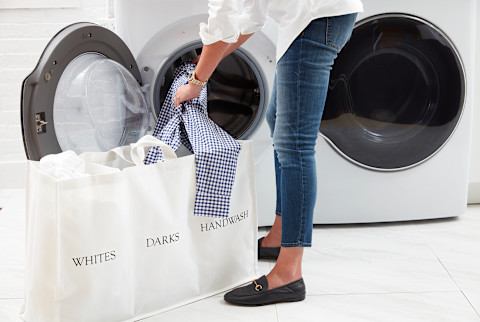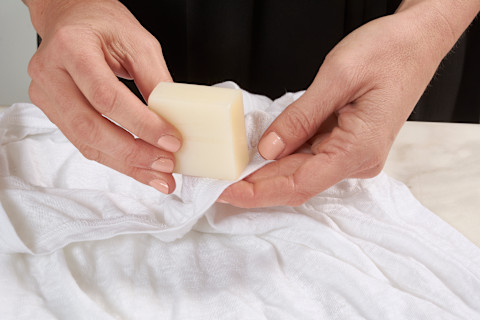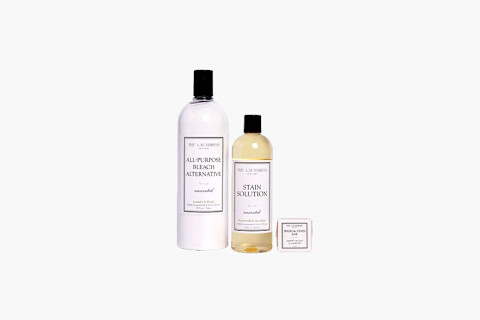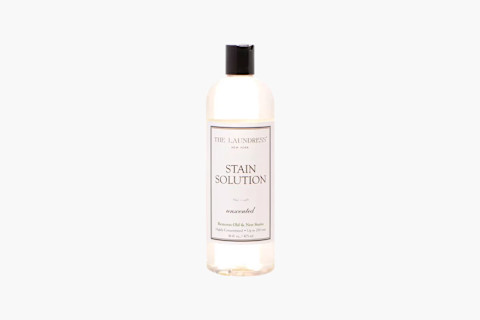You Only Need To Know 2 Techniques To Remove Your Most Common Clothing Stains

One of the perks of working over at mbg HQ is the many tastings that come through our kitchen. We've sampled everything from bone broth smoothies to BBQ jackfruit to turmeric-infused apple cider vinegar shots. But it's not always super clean, if you catch our drift.
Between these and all the lunch making, recipe video shooting, and coffee drinking that goes on around here, it's not uncommon to see a staffer call for stain-removing reinforcements in the company-wide Slack channel. A recent informal poll in said channel revealed a few common denominators in stain struggles. Any of these sound familiar?
- Turmeric
- Iced coffee condensation drips
- Beets
- Nut butter oils, oily salad dressing, MCT oils, any oil
- The juice from frozen blueberries (also, elderberry syrup)
- Charcoal
- Hot sauce
- Mascara on towels
- Armpit stains
- And the givens: chocolate and red wine
We turned to the founders of the original eco-friendly detergent company The Laundress, Gwen Whiting and Lindsey Boyd, to see if there’s any hope in mastering these dreaded messes when it comes to our clothes and linens. Good news—there is, and the even better news is that we only need to learn two techniques.
What NOT to do when you've got a stain.
First of all, don't panic. "My No. 1 major cringe is when people start treating a stain on the spot," Whiting tells us.
"The gut reaction is to grab any water-absorbing item, which is usually paper-based like a towel or tissue, and that makes a bigger mess because it leaves the pulp behind. Then, you have a bigger wet spot, the fabric is stretched and distorted, and it's so much more noticeable than if you'd just said 'oops.' I'm a huge proponent of waiting for the right time and the right tools to make a seamless stain-removal process."

What are the right tools for removing stains?
If you're in a pinch—and have access to a hand dryer (like the ones in restrooms) to mitigate the water mark—you can use a mixture of diluted soap and water, gently, to lessen the appearance of a stain.
Preferably, Whiting and Boyd advise saving the stain-removal process for when you're back at home. They advise stocking your arsenal with stain-lifting treatments that contain a high concentration of active enzymes, along with a chlorine-free oxygen bleach powder like sodium percarbonate.
"Our Stain Solution is specially formulated with plant-derived enzymes that target tannin-based, color-rich stains like coffee, wine, turmeric, beets, blueberries, and charcoal," says Boyd. The brand's All-Purpose Bleach Alternative, which is color-safe, helps keep fabrics bright and looking fresh. Also, "our biodegradable Wash & Stain Bar, made with ingredients like vegetable soap, borax, and essential oils, works perfectly for oil-based stains such as salad dressing, makeup stains, armpit stains, and ring around the collar."
To remove tannin-based food stains, follow these steps:
- Apply an enzyme-based pretreatment (like Stain Solution) to the affected area, and sprinkle the oxygen bleach granules (usually a capful of the All-Purpose Bleach Alternative) directly onto the solution to create a paste. Then, work the paste into the stain using a brush or your finger. (Keep in mind, you shouldn't use All-Purpose Bleach Alternative on items made of silk, wool, and cashmere. Instead, only use Stain Solution and cold water.)
- Soak the item in a basin with hot water—cold if you're treating a blood stain or washing silk or wool—and a capful of oxygen bleach up to an hour. Rinse the item and repeat treatment process until the stain has completely lifted. (Boyd's tip: For added cleaning power, pour hot water from a kettle or a faucet onto the affected area. The force of the water helps to do the work.)
- Launder the item as normal with your preferred detergent.
To remove oil-based stains and makeup, follow these steps:
- Grab a natural soap, ideally The Laundress' Wash & Stain Bar, and run it under cool to warm water. Work the bar into the stain. If the item is made of cotton, linen, or a durable synthetic, run the stain under hot water for added pressure.
- Let the item soak for 30 minutes to an hour. Rinse the garment with cool to warm water and press against the side of the basin. (Whiting's tip: Pit stains build up over time, so if you get into a pattern of applying a stain treatment under the arms with every wash, you'll never have to deal with that full buildup. You'll be preventing and removing the stains at the same time.)
- Launder as normal.
Shop The Laundress and use code mbg25 for 25% off site-wide.



